QuestionQUESTION: My rat had surgery to remove a fatty tumor about a little over a month ago, and I noticed almost right after her surgery another small lump appeared. I made a vet appointment and the vet told me that it could be a hernia, so to wait it out to see if it got bigger and just keep an eye on it. Well it has gotten a little bigger but it's still relatively small and its located by her right leg, but I think it's definately a hernia because it's more solid then the tumor felt that she had before her surgery. She is 17 months old, and my question is what happens if a hernia goes untreated? Is surgery the only way to fix this? I'm not sure at her age if a second surgery will be good for her considering she will most likely get another tumor down the road which will havwe to be removed.
Thank you for your time.
ANSWER: Heather
I have my doubts that the tumors your rat has are fatty tumors or hernias.
Here is why: Hernias are not found in that area that your describing on your girl. Is it her inner thigh, under her leg by her belly etc...?
Your girl is the prime age for mammary tumors. Starting right around her age is when they go through cessation of their estrus cycle and estrogen levels rise dramatically. Mammary tumor growth is fueled by estrogen and so the rat will start to sprout mammary tumors. Since mammary glands are distributed all over the under parts of the rats body, from the neck, chest,under the front paws and under arms, extending from her breast plate and extending down under her abdominal area, into the groin area and the inner thigh and even the creases/folds of the inner thigh and leg extending up towards the side. Basically any are from the neck down to the legs and groin is lined with mammary tissue. These tumors also vary in density depending if they are malignant or benign. Most of the time they are benign but the bad news is, they continue to return despite the surgery to remove them because the high estrogen levels keep them "fed" if that makes sense. This is why your rat has her second one and chances are, they will continue to multiply. This is one unfortunate downfall of being a female rat that is intact. Prevention is to spay the rat between 3 and 5 months old but any age is acceptable in order to prevent problems with the uterus etc... Once the ball is rolling however, chances are even after spaying a rat once she hits menopause and her body is creating the mammary tumors, there is yet one more way to prevent these tumors from growing back after the spay.
The treatment is done by using a hormone called Lupron. This hormone is injected once per month and it stops the production of estrogen. It is also used in ferrets to control adrenal insufficiency and it is also used in women with endometriosis and also is used for cancer of the prostate gland in men by stopping production of testosterone, among other uses in humans too.
Although I have not examined your rat, it just makes sense that these are not fatty tumors (which are uncommon in rats) and hernias in that area esp in a female rat is usually unseen.
My final question is this: Your vets experience with rats.
There are less than a few hundred certified exotic rats in the entire world, with only 47 in the entire state of California, 22 in the huge state of Texas, and some states like Kansas that has just 3 in the entire state and Idaho having only 1 in the entire state
Some states have none at all and this forces people to have to go out of state at times to seek care from a certified exotic vet. The UK only has a total of 10 and Japan has just 2.
That said, this means that there are vets that see exotics but are not properly educated in that area like they should be. What it says in their ads etc...is that they have a "special interest" in exotics.
I know many general vets that are great with rats, but others only learn the basics and are not aware of even half of what they should know. This is why I hold the position that I hold and I work for vets that see rats but are not exotic certified and my job is to pick up where the vet left off, usually aiding to diagnose the rats alongside the vet and discussing treatment plans with the clients as well as also providing Vets with brochures on rat care.
From my experience, a rat that produces tumors back to back at the age of 17 months is dealing with mammary tumors fueled by high levels of estrogen that is seen after menopause.
I wanted to ask, did the vet send the tissue samples off to pathology and if so, what were the results?
If you need to find another vet for a second opinion please allow me to help find one for your girl. If these are indeed mammary tumors, there are things that can be done to help prevent more from growing because they can claim her life prematurely.
Please look over my website about mammary tumors here:
http://www.freewebs.com/crittercity/allabouttumors.htm
looking forward to helping you!
Sandra
---------- FOLLOW-UP ----------
QUESTION: Sandra,
I did have a biopsy done on the tumor removed, and the results came back that it was a fatty tumor. I was relieved and not too surprised because I was giving her a lot human food not even realizing how unhealthy it was for her. She is strictly eating the blocks and she gets a few yogurt drops daily.
My vet is pretty good with animals, he has been treating my dog recently and was successful at removing the rats tumor. In the past he has taken care of a former pet rat I used to have years ago. He is no rat specialist but he is knowledgable and has a lot of resources and most importantly is affordable. There is a famous rat specialist in NYC but the consultation alone is over a hundred, I can't even imagine how much for the surgery.
As far as diet goes for rats, I hope what I am providing is appropriate...I heard it was?
Lastly, the tumor is located under her right leg by her lower stomach area...which made me think maybe it's her intestine? The good thing is that it has not grown much and I hope it stay this way.
Oddly enough, Mahdy's pet sister Winnie (same litter) has had no medical problems at all so far? I do notice that Mahdy eats almost double what Winnie eats..not sure if this correlates to anything? It's just ironic because they are both female white rats, same age and everything.
Thanks again,
Heather
AnswerHi Heather
I dont doubt the tumor may have been a lipoma but this simply means that it was benign. Most benign soft tissue tumors, fortunately, are made of fat (lipomas). They often occur just beneath the skin as a soft mass.
The chance it involved mammary tissue is high,however, but the good news is it was benign which most of the time they are.
I just have my doubts about this being a hernia since she has already popped one tumor and now this. I would have it removed before it becomes vascular. As for her diet, rodent blocks are great if she eats them, but that has to be boring for her even if she gets yogis. I wouldnt stop using the blocks but you can add other things to her diet to make it more interesting. Fresh or canned veggies like peas and carrots are a hit. Fruits from apples to watermelon....strawberries, you name it, they love it. Check out my website on diet info for more ideas.
http://www.freewebs.com/crittercity/ratsandahealthydiet.htm
As for the NYC vet that charges $100 for a consult...thats nuts. First time visit should not be really over $50 and thats kind of steep too. Its ridiculous that good care isnt always affordable. I have alot of names for you if you want since I assume you are in NY that are exotic vets but they are far from being over priced like that.
Where I work we always try to keep prices affordable, not allowing finances to get in the way of treatment. It would be a crying shame if someone had to forfeit treating their pet (any pet) because of the almighty dollar!! That just burns me thinking about it! LOL
Anyhow, I dont mean to go against what your vet says and again, I did not see your rat etc...but I just know from doing this kind of stuff with my eyes shut that it just isnt that easy for an intact female rat at the prime age of the end of her estrus cycles to pop one tumor and not a second. Just keep a look out for it.
I will answer your origial question though from before:
"She is 17 months old, and my question is what happens if a hernia goes untreated? Is surgery the only way to fix this? I'm not sure at her age if a second surgery will be good for her considering she will most likely get another tumor down the road which will have to be removed."
If it is a hernia, it will need removed because eventually it could push through the intestines which would be a disaster.This would in turn cut off blood flow and this would result in the tissues of the organ becoming necrotic (death to the tissues due to lack of blood flow) and the end result would be death to your rattie.
I would most certainly go for surgery sooner than later.
Again though, I have my doubts about what it is but no matter what if it is a tumor too, it will need removed as well before it becomes vascular and involves the rats entire body function for survival.
Unfortunately,once these tumors start there is no stopping them unless the estrogen levels are lowered like I said earlier, which means either spaying her OR the hormone injections. I would not spay my rat unless the vet has uber experience at it since it is invasive and requires proper implements for surgery and even a place to stay overnight to be observed by professionals.
Oh almost forgot....the rat that eats more, is that the one with the mass? Sometimes if rats have tumors, they eat twice as much because the tumor starts to become vascular and rob the rat of the nutrients they get from their food making them seem even more hungry than normal. They tend to drop weight despite their ravenous appetite. Usually this doesnt happen until the tumor gets bigger though. She may just love to eat:) And finally, almost forgot this one too (I am getting soooooo old geezeeee!!!!) she is NOT too old for surgery considering the fact you have taken good care of the girls and they have had good diets etc...and no past medical problems. She could live to be well over 3 years old! I had my 3 year old girl operated on twice and she lived to be nearly 4 years old. These rats have a strong will to survive. They are truly an inspiration to all of us! :)

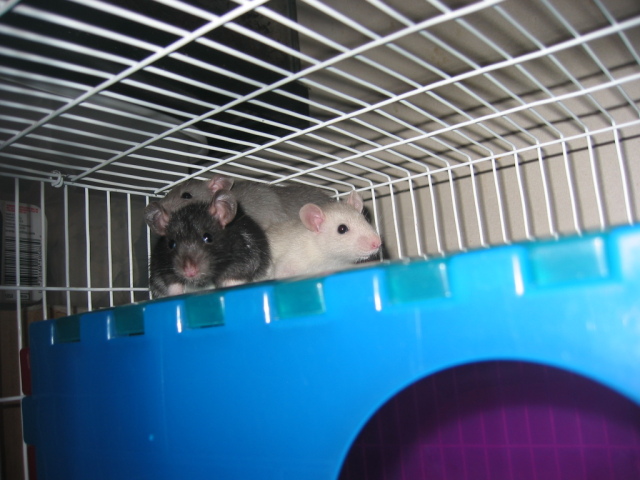 Rat play or foul play?
QuestionQUESTION: When my 5 week old rat is playful and
Rat play or foul play?
QuestionQUESTION: When my 5 week old rat is playful and
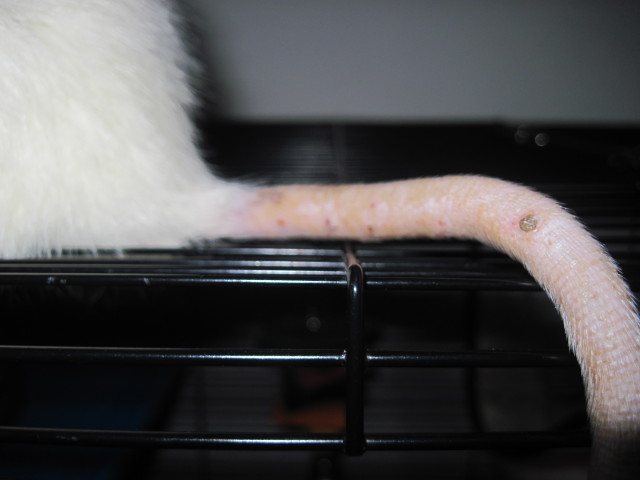 Mole or Tumor?
Question
Rat
I have two male rats that are around a yea
Mole or Tumor?
Question
Rat
I have two male rats that are around a yea
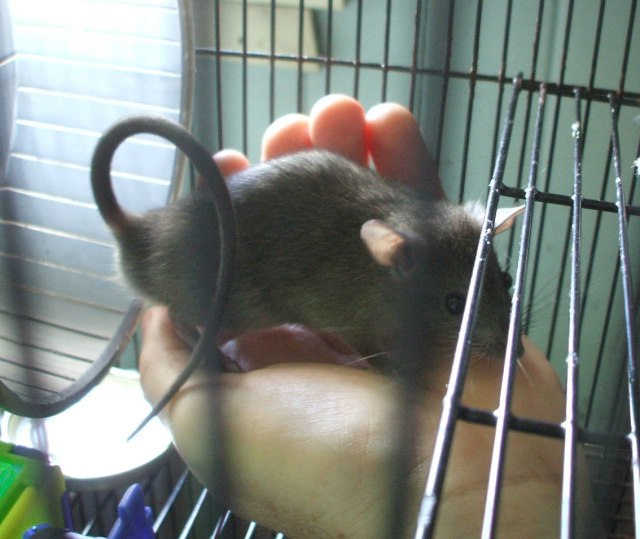 owning a wild rat
QuestionQUESTION: Hello Sandy,
I found your answer to
owning a wild rat
QuestionQUESTION: Hello Sandy,
I found your answer to
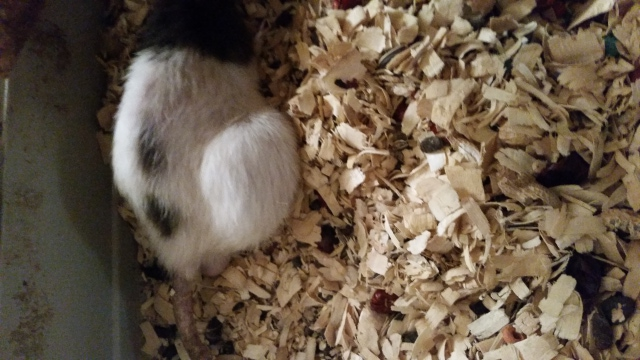 Tumor, Abscess, or Cyst and What to do
Question
Robin 1 Robin 2
Hey Irene, this i
Tumor, Abscess, or Cyst and What to do
Question
Robin 1 Robin 2
Hey Irene, this i
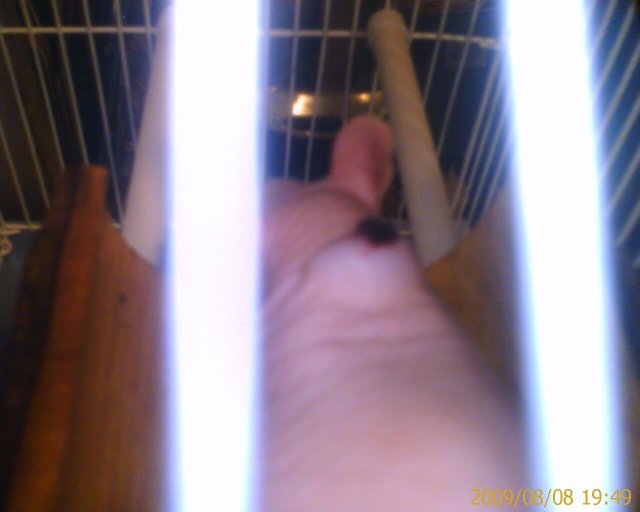 Hairless Rat w/growth between shoulder blades
QuestionQUESTION: I have a young hairless male, who is
Hairless Rat w/growth between shoulder blades
QuestionQUESTION: I have a young hairless male, who is